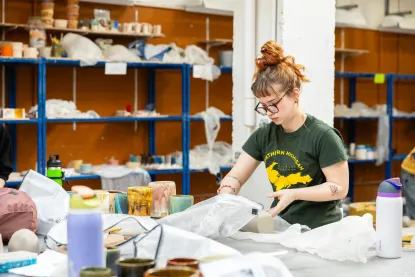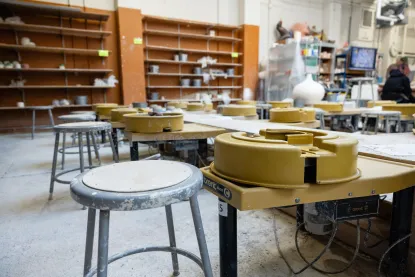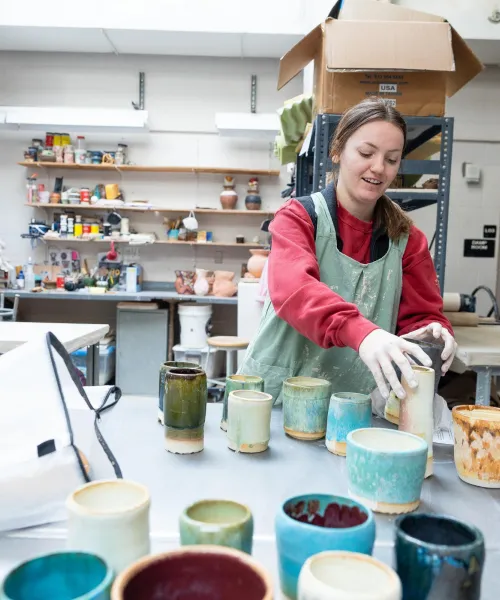Quick Links

About the Program
The Ceramics program is designed to provide students with a broad foundation of technical skills, from traditional forming to surface development. Upper-level courses focus on refining technical and conceptual skills, with a focus on complex mold-making and firing methods. The program encourages students to investigate and discover their own artistic approach, rather than following a single method.
Our state-of-the-art ceramic studio is available to all registered students. It features a glaze lab, various kilns (electric, gas, soda), and a wide array of equipment ( ball mill, clay mixers, pugmill). Upper-level students also receive personal studio spaces. The program is enhanced by exhibitions, workshops, and lectures by visiting artists.
Most students pursue the Bachelor of Fine Arts (BFA) degree. Our faculty are all practicing artists and designers. Graduates have gone on to careers as independent artists, educators, attended national graduate programs, apprenticed with renowned artists, and entered the industrial design field.
Ceramics Faculty
Ceramics Courses
ARTD 210 Ceramics: Foundations
4 credit hours
Offered: Fall, Winter
Introduction to the methods and techniques of producing ceramic objects, covering the various forming, finishing, and firing techniques. Students experience techniques ranging from pinch, coil, and slab construction.
ARTD 222 Ceramics: Wheel Forms
4 credit hours
Offered: Fall
Development of the traditional skills of throwing, along with glazing and firing procedures. Supporting information is derived from historical and contemporary wheel-thrown forms.
AD 322A Ceramics: Tableware Design
4 credit hours
Offered: Fall, even-numbered years
Prerequisite: AD 101 or AD 210, or instructor permission.
Working with commercial restaurant considerations, pieces created in this course will explore both functional and visual aesthetics of serviceware design. Students will have hands-on experience not only making tableware but also working with a kitchen to help create the ultimate dining experience.
AD 322B Ceramics: Surfaces
4 credit hours
Offered: Fall, odd-numbered years
Prerequisite: AD 101 and AD 210, or instructor permission.
Combining traditional and experimental surface techniques, students will create a collection of ceramic pieces that develops their personal approach to the ceramic material. Expanded construction methods and image transfer are highlighted as investigations of surface interaction on ceramic objects.
AD 430 3D Design Practices
4 credit hours
Offered: Winter, even-numbered years
Prerequisites: AD101, one 200-level 3D course (AD/ART 209, 210, 222, 223, or 224), and one 300-level 3D course (311a, 311b, 322a, 322b, 323a, 323b, 323c, 323d, 324a, or 324b); or instructor permission
This course is designed to further develop problem-solving skills with an emphasis in Ceramics, Sculpture, Metalsmithing/Jewelry Making, Woodworking, and Industrial Design programs. Students will explore a personal approach to form by engaging with ideological and theoretical sources. Individual solutions for construction and products are emphasized with a focus on current trends and issues in 3D studio art fields.

Ceramics Studio
The ceramics studio is a 6,000-square-foot facility designed to support all aspects of a student’s work in this medium. All areas of the studio are well ventilated, providing a safe and comfortable working environment. Two large skylights provide ample natural light. The facility is divided into four main areas: the studio, the clay/glaze lab, the plaster mold making room, and the kiln room. The studio is equipped with 20 motorized Brent pottery wheels with individual workstations, large stainless steel hand-building tables, a Brent slab roller, Northstar extruders, and a Ricoh decal printer. There is a fully outfitted photographic room set up to document finished artwork. The glaze/clay lab is equipped with a materials lab, stainless-steel raw-material bins, spray booth, ball mill, two Soldner clay mixers, and a Peter Pugger VPM-60 pug mill. The kiln room houses two downdraft gas kilns, 70 cu. ft. & 50 cu. ft. each outfitted with oxy probes and sigma controllers, 25 cu. ft. cross draft Soda Kiln, five 19 cu. ft Bailey Top loading oval electric kilns and 2 test kilns. The ceramics studio certainly ranks among the finest university studios in the country.
Ceramics FAQ
What’s the difference between earning a Bachelor of Fine Arts (BFA) in Ceramics and a Bachelor of Arts (BA) or Bachelor of Science (BS)?
The BFA in Ceramics is considered the professional studio degree. It includes more credits in the ceramics emphasis, additional studio requirements in areas such as sculpture, drawing, metals, and woodworking. The BFA also has more art history requirements and does not allow a minor.
The BA and BS degrees offer greater flexibility, allowing students to pair their art and design studies with a minor in another field. For example, a major in ceramics with a minor in music (20 credits). The BA also includes a language requirement.
Does the school require a portfolio review before you are accepted into our programs?
If you are accepted to the university, you may pursue a degree within the School of Art & Design. While a portfolio is not required for entry, you may choose to present one to a professor in your studio area. Faculty can use this portfolio to determine whether you qualify for advanced placement credit (replaces both the course and credit hours), a waiver (replaces the course but not the credit hours), or to identify the appropriate studio level for you to begin. Portfolios may be reviewed during a campus visit or during a faculty member’s office hours during the semester.
Although there is no required portfolio review to enter the program, all Art & Design majors are required to complete a portfolio review with faculty (Individual Art Review, AD 303) during the twelfth week of each semester.
For information on general University admission requirements, contact the Admissions Office.
What will we need for supplies or equipment?
- Introductory Courses (ARTD 210: Foundations and AD 222: Wheel Forms): tool kits are supplied as part of the intro courses.
- Advanced Course (AD322 A/B Seminars): Students must have basic safety gear (safety glasses, respirator) and personal hand tools suited to their work.
- Technology: All Art & Design majors are provided with an Apple MacBook and professional software for digital imaging and 3D rendering.
What are the prospects for employment with a degree in Ceramics?
Ceramics is a competitive field of study, but the employment outlook is strong. Graduates may pursue careers as studio artists, continue their education with graduate programs and teach at the university level, work in design or industrial applications, or explore a variety of other opportunities within the ceramics field.
What will I study in the Ceramics program?
The Ceramics program gives students a broad, hands-on experience with clay, from hand-building and wheel throwing to glazing, firing, mold making, and slip casting. Each studio course includes a ceramics history component that explores ceramics within the context of that course’s focus.
In the first semester, students focus on the physical aspects of ceramics, including forming, finishing, and firing, with an emphasis on sculptural techniques. The second semester centers on the wheel-thrown vessel. In the following semester, students explore the technical aspects of clay and glaze formulation, refine the firing process, and work with complex mold making. During the final two semesters, students develop a personal approach to the material and create a cohesive body of work for exhibition.
Are there scholarships available for incoming first-year students?
For information about scholarships for incoming freshmen, please visit the Scholarships & Financial Aid page.
